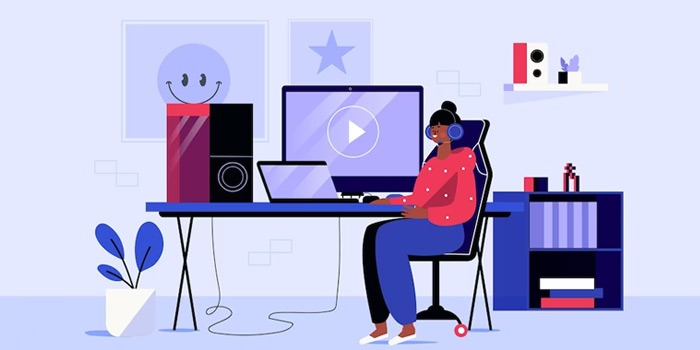In the speedily evolving world of digital media, animation has become an indispensable tool for businesses and creative professionals alike. Whether you’re looking for 2D animation services providers to invent engaging advertisements, captivating explainer videos, or immersive cinematic experiences, finding the right animation business is crucial. According to Statista, the source estimated that, in 2022, the value of the global animation market quantum to over 391 billion U.S. dollars, up five percent from 372.4 billion dollars a year earlier. The yearlong mandala was forecast to continue to grow throughout the decade, surpassing 587 billion dollars by 2030.
This blog explores the realm of 2D and 3D animation services, highlighting the key factors to assume when selecting a provider. From skillful storytelling to cutting-edge technology, let’s dive into the world of animation and uncover how it can transmute your graphic content.
Understanding Animation Services
Animation services encompass a broad range of techniques and styles, but two of the most approved ones are 2D and 3D animation. 2D animation involves creating movement in a two-dimensional space, using flat images and traditional hand-drawn or digital techniques. On the other hand, 3D animation brings objects and characters to life in a three-dimensional environment, utilizing computer-generated imagery (CGI) and advanced software.
Benefits of 2D Animation Services

2D animation services give a timeless wheedle and flexibility that makes them ideal for various projects. They can be used to invent vibrant and colorful characters, voice complex concepts in a simplified manner, and evoke nostalgia through their traditional artistry. Whether it’s a brief promotional video or an engaging e-learning module, 2D animation captivates audiences with its expressive storytelling capabilities. Furthermore, 2D animation services are often more cost-effective and quicker to produce than their 3D counterparts, creating them an excellent choice for projects with tighter timelines or budgets.
Exploring 3D Animation Services

With technological advancements, 3D animation has emerged as a powerful tool that can deliver highly realistic and immersive graphic experiences. It allows for detailed character modeling, lifelike simulations, and dynamic camera movements, creating it perfect for creating stunning graphic effects and lifelike virtual worlds. 3D animation company finds extensive applications in industries such as gaming, film production, architectural visualization, and item prototyping. While the production procedure for 3D animation can hold longer and mesmerize more resources compared to 2D animation, the stop results often justify the investment. The level of realism and depth achievable with 3D animation opens up untried avenues for creativity and storytelling.
Different Types of 2D Animation: Exploring Their Uses and Examples
2D animation is a versatile and captivating medium that offers a broad range of styles and techniques. From traditional hand-drawn animation to digital cutout animation, each kind brings its own fresh wheedle and appeal. Let’s delve into some approved types of 2D animation and explore their various uses with real-world examples.
-
Traditional Hand-Drawn Animation
Traditional hand-drawn animation, also known as cel animation, is the oldest and most vintage form of animation. It involves creating each frame by hand on individual transparent cels and photographing them sequentially. This technique gives a sense of organic and ichor movement to characters and objects. The hand-drawn animation is commonly used in feature films, television shows, and commercials. An excellent instance of traditional hand-drawn animation is Disney’s “”The Little Mermaid,”” where the characters and their movements are brought to life with meticulous hand-drawn detail.
-
Digital Cutout Animation
Digital cutout animation is a contemporary technique that combines traditional animation with the efficiency of digital tools. It involves using pre-drawn, vector-based character parts, or “”puppets,”” that can be manipulated and animated using the software. This technique is often used in explainer videos, educational content, and web series. A notable instance of digital cutout animation is the approved television exhibit “”South Park,”” where the characters are digitally cut out and animated using computer software, while having a different and humorous style.
-
Motion Graphics Animation

Motion graphics animation focuses on creating visually appealing and dynamic animations using typography, shapes, and graphical elements. It is widely used in title sequences, promotional videos, and presentations. Motion graphics animation utilizes kinetic typography, animated infographics, and visually captivating transitions to voice information or evokes emotions. A well-known instance of motion graphics animation is the opening title sequence of the film “”Catch Me If You Can,”” where the text and graphics twirl seamlessly to invent an engaging introduction.
-
Stop Motion Animation
Stop motion animation involves documenting a series of quiet images of physical objects or models and then sequencing them to invent the illusion of movement. This technique can be achieved using various materials such as clay, puppets, or everyday objects. Stop-motion animation is approved in feature films, commercials, and music videos. The best instance of stop motion animation is the film “”Coraline,”” which combines 3D-printed puppets and intricate area designs to invent a visually stunning and immersive world.
-
Rotoscoping Animation
Rotoscoping animation involves tracing over live-action footage frame by frame to invent realistic and lifelike animations. This technique gives the animation an ichor and natural movement, directly referencing real-life actions. Rotoscoping animation is often used in music videos, video games, and commercials. An iconic instance of rotoscoping animation is the film “”A Scanner Darkly,”” where the actors’ performances are captured using live-action footage and then transformed into stylized, animated visuals.
-
Whiteboard Animation

Whiteboard animation, also known as video scribing or doodle animation, involves creating illustrations and text on a white background, mimicking the procedure of drawing on a whiteboard. It typically features a hand that appears to draw the images and text in a step-by-step manner, accompanied by narration or a voiceover. Whiteboard animation is commonly used in explainer videos, educational content, and presentations. It simplifies complex concepts and engages followers through its dynamic and engaging style. An instance of whiteboard animation is the approved TED-Ed series, where educational topics are visually explained using animated illustrations and a hand drawing on a whiteboard.
-
Cutout Animation
Cutout animation, also known as collage animation, involves using pre-existing images or cutout elements and animating them in a method that creates movement. It can be done manually with physical cutouts or digitally using image-editing software. Cutout animation allows for creative storytelling with a different graphic style. It is often used in brief films, music videos, and advertisements. A notable instance of cutout animation is the music video animation for the song “”Take on Me”” where a combination of live-action and hand-drawn cutout animation creates a visually stunning and memorable experience.
These additional types of 2D animation showcase the diverse range of techniques and styles available in the animation industry. Each kind brings its own fresh graphic appeal and storytelling approach, allowing animators and creators to explore different avenues of creativity. By understanding the characteristics and uses of these various animation types, you can further enlarge your creative possibilities and pick the most suitable style for your project.
The world of 2D animation is rich with possibilities, offering various techniques and styles to suit different creative visions and project requirements. Whether it’s the timeless taxidermy of traditional hand-drawn animation or the dynamic versatility of motion graphics animation, each kind brings its own fresh magic to the screen. By understanding the different types of 2D animation and their uses, you can make informed decisions when choosing the right animation style to bring your concepts to life and mesmerize your audience.
Choosing the Right Animation Company
When selecting an animation company, it’s necessary to imagine various factors to ensure you explore the right fit for your project. First and foremost, assess the company’s portfolio and assess whether its animation style aligns with your vision. Look for a diverse range of projects that showcase their expertise and creativity.
Next, imagine the level of time and ability the animation business possesses. Check their track write and client testimonials to gauge their reliability and professionalism. A reputable animation business should hold a team of talented animators, storyboard artists, modelers, and other specialists who can bring your concepts to life.
Additionally, ask about the software and kit they use. Animation companies equipped with cutting-edge technology and industry-standard software can deliver superior results. Whether its industry staples like Maya and Blender for 3D animation or Adobe After Effects and Toon Boom Harmony for 2D animation, make sure the business utilizes the latest kit to touch your project’s requirements.
Furthermore, communication and collaboration play a crucial niche in the animation process. A good animation business should hold a streamlined workflow, clear communication channels. A dedicated project manager who can keep you updated on the progress and address any concerns along the way.
Conclusion
In the competitive world of digital media, harnessing the power of animation can give your graphic content an edge. Whether you opt for the versatility of 2D animation or the realism and depth of 3D animation, choosing the right animation business is paramount. By considering factors such as animation style, experience, software proficiency, and communication, you can ensure a successful collaboration that brings your concepts to life. Embrace the world of animation services and unlock a universe of creative possibilities for your business or artistic endeavours. Furthermore, if you are looking for 2D animation services providers, then contact Animetus.

